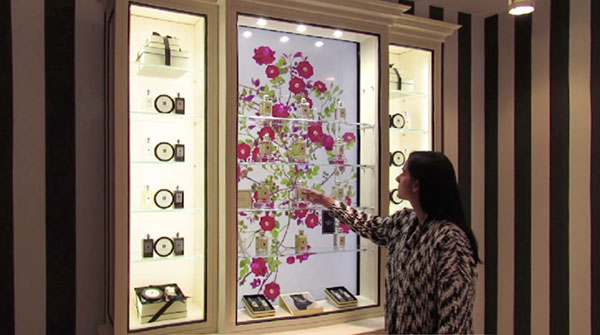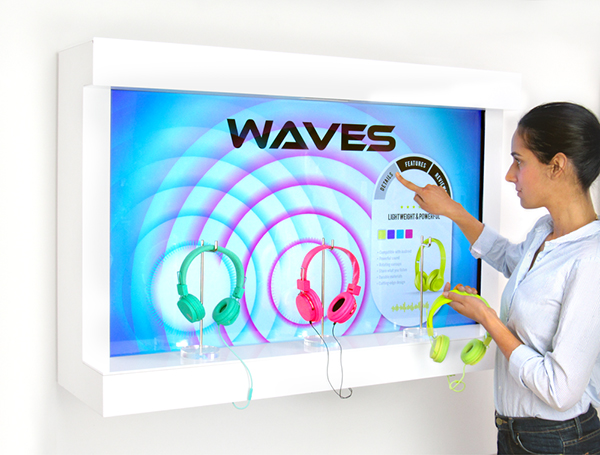Retail Technology Enhances Real-Life Browsing
by Kirsten Nelson
There’s a new kind of retail. And it’s a retail of amusement. Where we used to have to shop for utility, now we go for enjoyment. If we actually get off the sofa and enter a store out in the real world, it’s because we’re seeking engagement or variety. We’re seeking knowledge and expertise. In short, we actually want to interact with people in the store.
That being the case, just as when we make the effort to visit an amusement park, a movie theater or a themed restaurant, we’re looking for some sort of wonder that makes the experience memorable and engaging. If retail can provide both of these experiences — technical wizardry worthy of an Instagram moment, and the human touch of efficient and helpful interaction — then we may have finally arrived at the stores that we have actually always wanted.
Let’s Go Experiencing
It might be said that there two types of retail experiences: shopping and browsing. Shopping has a direct outcome that can often be served by a quick search online. But browsing, that’s all about the experience.
Browsing is the indulgence of a favorite pastime through the acquisition of more tactile and sensory knowledge. And those sensibilities are now served by a wide array of audiovisual, interactive, immersive and AR technologies that have been integrated into the store environment to bridge the divide between digital and physical worlds.
The examples are endless. Stationery brands are opening coffee shops filled with goods for their journaling clientele. Clothing retailers are offering a chance for customers to design their own pieces, or develop and print 3D versions of their own accessories via rapid prototyping.
This “hybriding,” as David Title, Chief Experience Officer of Bravo Media, describes it, might be the most successful means of differentiating the in-store experience from the online experience yet. These retailers, he said, “are becoming more of a resource than just a place where you go and purchase goods. They’re asking, ‘What can I offer in the real world that I can’t offer online?’”
An in-store class might be superior to watching a video on a website, he described, adding, “If you can convince people to come into a store, the same basic truths continue to hold: The longer they stay in the store, the more likely they are to purchase something.”
Is Smart Technology Emotionally Intelligent?
So, now you’re in a store and you’re learning about products. But they’re also learning about you. Where there is technology, be it digital signage screens equipped with analytics tools, or “smart shelves” that track when objects are picked up and by whom, there is intelligence gathered.
That data has long been considered valuable to retailers, but it’s recently become apparent that it doesn’t mean much without more context. Knowing the number of shoppers who have stood in front of a screen, how long they remained there, and maybe even their gender or age doesn’t reveal their motivations for purchasing or passing on an item.
To connect those dots requires another layer of intelligence. “We are bullish on emotional data,” said Ed King, Principal Consultant - Retail Customer Experience, with HighStreet Collective. “That goes beyond how long they looked at something, and into their reaction. They might have looked and at it and grimaced, or they might have smiled.”
As emotional analytics tools become more prevalent in retail applications, there are new opportunities for technologists who design and integrate those attention-grabbing audiovisual experiences. If they can help interpret the data and work with content creators and retail consultants to “infuse sentiment and emotional context to these experiences,” as King described, then they can reach a new level of engagement.
Ultimately, King said, “Technology should make people more human.” More than simply displaying emotion-triggering content, that means considering the tactile and atmospheric elements of the retail experience.
Trends indicate that the standalone video wall or bluntly placed video screens are on the wane. In the experience era, the winners are designs that integrate video displays into creative fascia that coalesces with decorative elements throughout a store. Combining digital signage with the textures of a store design, King said, “where it’s not just a 42-inch panel on the wall showing commercials, but instead evolves into an illustrative experience within the story,” is the goal.
“Digital signage is great but it can’t be used in a silo,” he elaborated. “It needs to be reacting to you, you’re using voice or gesture to command things, or it lights up LED displays next to a product using RFID. We can build these bespoke fantastical experiences that are memorable and engaging. That gives people the urge to come back and provides these Instagrammable moments to share on social.”
The shift toward more emotion-led experience design indicates another shift in retail, that of the main technology decision-maker now being the CMO rather than the CIO. With the CMO at the wheel, “there’s more talk now of how each screen fulfills a specific purpose,” observed Laura Davis-Taylor, King’s co-founder and Principal Consultant - Retail Experience Strategy with HighStreet Collective. Now the marketing-centric design process includes compliance testing to prove “that you can breathe life into a zone in the store,” she noted.
It Looks Good, But Does It Sound Good?
There are of course other senses to entice when attempting to attract, engage and retain those who chose an in-store experience. Those would include hearing, and audio is taking on the specificity and well curated nature of retail design’s new understanding of engagement.
Rather than going with bland music and audio that coats a setting with one repetitive hue, spotlights of music programming and even pinpointed audio zones are happening. It’s the boutique approach to boutique audio.
There is much vitality in creating stores that deliver a sense of uniqueness or special inclusivity to those who shop within them. And music definitely helps create what audiovisual impresario David Schwartz, President of Essential Communications describes as “the old-school, boutique-level service” that brings an air of refined personal connection to shopping.
“We need to continue working on creating more organic experiences for people,” Schwartz emphasized. “When you walk into any store and it’s the same music, that’s not powerful anymore. It’s all about a well curated experience.”
To achieve that sense of high style requires some customization on the visual aesthetics of audio. Some of Schwartz’s clients want to see gorgeous restorations of vintage speaker cabinets, some want totally invisible audio gear.
That’s a shift that loudspeaker manufacturers are noticing, too. The complete boutique experience and its attendant very specific decor customization tends to require either total invisibility or bold declarations both physically and sonically.
“Retail spaces are becoming more concerned with creating a better atmosphere for their shoppers and therefore are more focused on ways of keeping them in the store longer, and making sure shoppers remain focused on the things they want them to focus on,” observed Simon Wehr, Director of Commercial Products with Dana Innovations’ Sonance brand. “To do that, the music can’t be a distraction, it needs to match the atmosphere they’re trying to create.”
Ultimately, Did the Experience Create Joy?
As retailers figure out their next move for the brick and mortar space, arguments can be made for any one of a number of new business models. The melding of digital and physical is a constant, but brands differ on their approach to delivering product. Some opt for ordering in store with home delivery like an online experience, some opt for online orders picked up in person at a mostly empty, hospitality-centric retail space.
“People are talking about omnichannel a lot, going back and forth between ordering in store or ordering online, but it’s really just about making the shopping experience joyful,” observed Trevor Sumner, CEO of Perch Interactive.
That’s where AV and experience design comes in, he elaborated. “For the first time, we have the technology to figure out who the customer is, and what product they’re picking up. Now you can personalize the experience for each and every shopper in interesting ways. Imagine if every time I picked up a product, a video comes up and tells me more about it or delivers content that reflects the brand. What if I could explore each of those products with an entertaining experience? How much longer would I stay in the store, and how many additional accessories would I buy?”
The videos produced for interactive shelves produced by Perch and other creative technology agencies are carefully developed to match different demographics who might show interest in a product. There are personalized appeals for women, men, older or younger people. “It’s opened up a new wave of creativity about the in-store canvas. It’s much more than looping video now,” Sumner noted.
Retailers and store associates love the technology, seeing it as a shortcut to explaining product features and opening the door to a new level of conversation with customers. But the integration of video content needs to be thoughtful, not just an invitation for shoppers to wander zombie-like through a store, staring through AR apps on their phones.
To avoid that scenario as mixed reality and augmented reality arrive in stores, experience designers will be collaborating closely with content creators, brand agencies and retailers to make sure the look and feel is right for their clientele.
When it’s done right, there is a bit of magic in the bridging of the digital and physical retail worlds. And that’s what everyone wants. When you look at the brands that are really getting it, Sumner said, they’re getting away from shopping as a chore and engaging fully in browsing for fun. “The whole question is whether your experience is an enjoyable one.”







